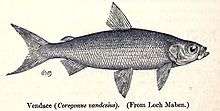Coregonus vandesius
| Coregonus vandesius | |
|---|---|
 | |
| Scientific classification | |
| Kingdom: | Animalia |
| Phylum: | Chordata |
| Class: | Actinopterygii |
| Order: | Salmoniformes |
| Family: | Salmonidae |
| Genus: | Coregonus |
| Species: | C. vandesius |
| Binomial name | |
| Coregonus vandesius (J. Richardson, 1836) | |
| Synonyms | |
|
Coregonus gracilior | |
Coregonus vandesius, the vendace, is a freshwater whitefish found in the United Kingdom. Population surveys since the 1960s have revealed a steady decline and the fish is no longer present in some of its previous haunts but is still present in Bassenthwaite Lake and Derwent Water. The main threats it faces are eutrophication and the introduction of alien species of fish which eat its eggs and fry. The International Union for Conservation of Nature has rated its conservation status as "endangered".
Taxonomy
Most authorities now consider Coregonus vandesius to be a subjective synonym of Coregonus albula, which is a more widespread North European freshwater whitefish species.[2] Both taxa are also known by the common name vendace. The status however remains controversial, and FishBase still lists C. vandesius as a separate species,[3] reflecting the recent treatment of the European freshwater fish fauna by Kottelat & Freyhof (2007).[4] Another synonym of British C. vandesius is C. gracilior.[3]
Biology
Coregonus vandesius inhabits deep, cold lakes, and uses planktonic crustaceans, such as copepods, as its primary food source. The fish does not migrate and has a life span of about six years. The species is now Britain's rarest fish.[2]
Distribution and habitat
The vendace has only ever been known as a native species at four sites in Britain: Bassenthwaite Lake and Derwent Water in the English Lake District, and the Castle Loch and Mill Loch in Lochmaben, Scotland.[5] The species is thought to have died out at all of these sites except Derwent Water. The Castle Loch population disappeared in the early part of the 20th Century, and the Mill Loch population disappeared in the 1990s. The fish has not been recorded at Bassenthwaite Lake since 2001, but was recently rediscovered in 2014.[6] The declining populations of the fish are thought to be due to introduced species that utilise the native vendace as a food source, and also due to pollution.[5] For example, a water treatment works near the lake had been overflowing with raw sewage at times of high water levels, causing severe algae blooms that were depleting the lake's oxygen supply, but the plant was to be renovated in 2004 in order to prevent this.[7]
Status
This fish has a restricted range, with a total area of occupancy of less than 500 km2 (190 sq mi). The current population trend is unknown and the main threats are thought to be eutrophication and the introduction of alien species. The International Union for Conservation of Nature has rated its conservation status as being "endangered".[1]
Coregonus vandesius was introduced to Loch Skene in Dumfries and Galloway, Scotland, in the 1990s as an attempt at ex-situ conservation after the severity of habitat deterioration at Bassenthwaite was noticed. This has proved largely successful and Loch Skene now has nearly ten times the number of vendace per hectare as Derwent Water according to a survey carried out by the Centre for Ecology and Hydrology. Conservationists hope to reintroduce the fish to Bassenthwaite Lake once the habitat is restored.[5]
References
- 1 2 Freyhof, J.; Kottelat, M. (2008). "Coregonus vandesius". IUCN Red List of Threatened Species. Version 2013.2. International Union for Conservation of Nature. Retrieved 25 January 2016.
- 1 2 Winfield, Ian J.; Fletcher, Janis M.; James, J. Ben (2004), "Conservation ecology of the vendace in Bassenthwaite Lake and Derwent Water, U.K." (PDF), Annales Zoologici Fennici, 41: 155–164
- 1 2 Froese, Rainer and Pauly, Daniel, eds. (2010). "Coregonus vandesius" in FishBase. January 2010 version.
- ↑ Kottelat, M. & Freyhof, J. (2007). Handbook of European Freshwater Fishes. Cornol & Berlin: Kottelat & Freyhof.
- 1 2 3 "Ice Age fish thrives in new home", BBC NEWS, 2008-02-27, retrieved 2010-01-02
- ↑ Extinct fish found in the Lake District after millions spend on cleanup work, www.independent.co.uk, accessed 9th October 2014
- ↑ "Algae threatens rare fish", BBC NEWS, 2002-11-27, retrieved 2010-01-02
